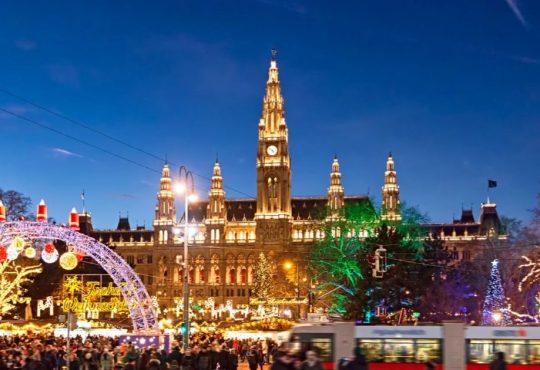In a world flooded with filters and curated images, finding stunning villages that are both visually breathtaking and deeply authentic is becoming increasingly rare. While many places chase social media fame, some villages have preserved their true essence, offering awe-inspiring beauty without feeling like mere backdrops. These stunning villages prove that it’s still possible to discover corners of the world that captivate both the eye and the heart.
These picture-perfect destinations showcase photogenic landscapes, charming streets, and an unmistakable sense of place. Whether tucked away in the Alps, perched on Mediterranean cliffs, or nestled within misty rice terraces, these villages perfectly balance visual allure and cultural authenticity.
Most Stunning Villages That Feel Like Real-Life Fairytales
1. Hallstatt, Austria: A Fairytale Framed in Reflection
Hallstatt feels like a watercolor dream come to life. Nestled between the towering Dachstein Alps and the mirror-like waters of Lake Hallstatt, this Austrian gem combines natural grandeur with architectural charm. Soft pastel wooden chalets cling to the hillside, adorned with overflowing flower boxes in spring and gently frosted roofs in winter. The village’s reflection on the lake—especially at dawn or dusk—doubles its magic, crafting scenes so picturesque they seem unreal.
And yet, Hallstatt’s beauty runs deeper than its views. The town has been continuously inhabited since prehistoric times, built on the legacy of salt—”white gold”—mined here for over 7,000 years. Locals still lead tours into the mountain to showcase the ancient salt tunnels. The bells of the Lutheran church echo across the lake while narrow alleys wind toward centuries-old shops offering hand-carved wooden toys and traditional garments. Despite becoming one of the most photographed places on Earth—and even being replicated as a theme park village in China—Hallstatt has resisted turning into a tourist machine.
Why It’s Authentic: The salt mines continue to sustain the local economy, and many families have lived here for generations, preserving customs like folk dancing, lake fishing, and artisan salt production that predate the tourist boom.
2. Shirakawa-go, Japan: Where Thatched Roofs Meet the Snow
Shirakawa-go, a village frozen in time, is in the mountainous folds of Japan’s Gifu Prefecture. Its most iconic feature is the gassho-zukuri farmhouses—massive wooden homes with sharply sloped thatched roofs resembling hands pressed together in prayer. Built to endure some of Japan’s heaviest snowfalls, these architectural wonders are more than historical curiosities—they are living, breathing homes passed down through generations.
Every winter, the village becomes a snowy wonderland. When soft illumination lights up the snow-covered rooftops during the Shirakawa-go Light-Up festival, it feels like entering a scene from a magical animation. But even beyond winter, the village pulses with authenticity. Rice paddies ripple in the breeze, locals harvest silk, and firewood is still chopped by hand. Many residents operate their gassho homes as minshuku (family-run guesthouses), inviting travelers not just to sleep but to eat home-cooked meals, wear yukata robes, and wake up to mountain mist and the sound of running water.
Why It’s Authentic: Families have lived in these traditional houses for hundreds of years and still embrace seasonal farming, silk weaving, and hospitality as an extension of their heritage, not a performance for tourism.
3. Oia, Santorini, Greece: Sunset Capital With Soul
Oia is instantly recognizable—its cliffside cluster of whitewashed homes, cobalt domes, and narrow marble pathways is iconic. The sunsets here, where the golden light melts into the Aegean Sea, have earned global fame, inspiring painters, poets, and thousands of photographers. Beneath this postcard-perfect image is a vibrant community with stories older than the volcanic caldera.
Oia reveals its soul in quieter hours, especially early mornings before the cruise ships arrive. Seagulls call overhead as fishermen mend nets along the Ammoudi Bay harbor. Older women sweep the stone steps and prepare breakfast pastries using family recipes handed down through generations. Tucked into historic captains’ homes, small maritime museums preserve memories of Oia’s bustling 19th-century shipping era. Local taverns serve domatokeftedes (tomato fritters) and sun-dried octopus, flavors of a seafaring legacy rather than tourist trends.
Why It’s Authentic: Many residents still live in ancestral cave homes, operate traditional inns and bakeries, and celebrate Greek Orthodox festivals that remain sacred community affairs, untouched by the selfie culture just a few steps away.
4. Göreme, Turkey: Where Caves and Culture Collide
Göreme rises from the Cappadocian plateau like a vision from another planet. Its surreal rock formations, fairy chimneys, and soft tuff cliffs are carved with ancient homes, churches, and monasteries hewn directly from the stone. As dawn breaks, dozens of hot air balloons lift into the sky, illuminating the village in a kaleidoscope of colors—but beneath this photogenic spectacle, Göreme hums with the enduring rhythm of Anatolian life.
The village has been continuously inhabited for thousands of years, serving as a shelter for early Christians and nomadic Turks. Today, the rock-cut dwellings still function as family homes and cozy cave hotels, where stone walls keep cool in summer and warm in winter. Pottery workshops line the streets, where artists shape terracotta clay using techniques inherited from the Hittites. Farmers tend to vineyards and flocks, and tea houses buzz with conversation as the village elders gather to discuss harvests, politics, and family tales.
Why It’s Authentic: Unlike other towns in Cappadocia, Göreme retains a substantial local population who still live, work, and raise families in the rock-carved dwellings. Tourism complements but does not replace the deeply embedded craft, agricultural, and communal culture.
5. Giethoorn, Netherlands: Venice of the North—Without the Crowds
Giethoorn floats in a whisper of calm. This car-free village in the Dutch province of Overijssel is woven together by a gentle network of canals, over 170 wooden bridges, and walking paths that wind past thatched-roof cottages and gardens in riotous bloom. Here, the loudest sound you’ll hear is the soft chug of a whisper boat gliding past or perhaps a duck splashing in the reeds.
Unlike Venice, which bears the weight of overtourism, Giethoorn maintains a remarkable sense of serenity, particularly outside of peak summer weekends. Its residents, many of whom are retirees, gardeners, or artists, take pride in their tidy homes and community spirit. Bicycles rest against willow trees, geese roam the meadows, and local cafés serve hearty Dutch pea soup and farmhouse cheeses with quiet authenticity. Life is slow, and visitors are gently expected to match the pace.
Why It’s Authentic: While the village sees its fair share of curious travelers, its core remains residential and traditional. Families have lived here for generations, and many still tend to vegetable gardens, raise livestock, and maintain boats for personal use, not performance.
6. Chefchaouen, Morocco: Fifty Shades of Blue and Tradition
Set high in the Rif Mountains of northern Morocco, Chefchaouen dazzles with its medina awash in blue, from the pale sky to deep indigo. Every wall, stairwell, and window frame seems dipped in the same dreamlike palette, said to have originated from Jewish settlers in the 15th century as a symbol of peace and heaven. It’s one of the world’s most visually distinctive towns, luring photographers and wanderers alike.
But beyond the blue, Chefchaouen is a stronghold of Moroccan mountain culture. Locals speak Arabic and Tamazight (Berber), and the town’s small plazas echo with the sound of live Gnawa music and prayer calls. Women in striped djellabas weave wool and spin threads by hand in courtyards. Saffron-scented couscous steams from open doors, while hammams remain part of weekly rituals, not just spa experiences. Nearby, goat herders lead their flocks across dusty hills, and herbalists blend traditional remedies based on centuries-old knowledge.
Why It’s Authentic: While visitors flock for the aesthetics, the blue paint is rooted in cultural meaning, not design trends. Families still own the homes, shop at the medina’s daily markets, and uphold religious, culinary, and artisanal traditions with fierce pride.
7. Reine, Norway: Arctic Beauty in Stillness
Reine, perched on the dramatic edges of Norway’s Lofoten Islands, is a village where nature’s raw power meets serene human scale. Crimson rorbuer—traditional fishermen’s cabins—dot the shoreline like flecks of paint beneath jagged, snow-dusted peaks. Fjords frame the village, so they still mirror the sky. During the summer’s midnight sun, the light casts a golden sheen that softens the harsh Arctic edges, blurring the line between day and dream. In winter, the Northern Lights arc over the harbor, transforming the night into a swirling canvas of greens and purples.
Despite its global rise in popularity among photographers and travel bloggers, Reine has carefully preserved its identity. Locals still cast nets in the same waters as their ancestors, returning each day with salted, dried, and stacked cod in towering wooden racks. Even the accommodations reflect this duality of beauty and heritage—many rorbuer have been converted into cozy guesthouses but retain their humble maritime soul. You’re likelier to hear the hum of fishing boats than loudspeakers, and the village doesn’t trade authenticity for modern flash.
Why It’s Authentic: Reine’s daily rhythm revolves around fishing seasons and weather patterns. Families who’ve lived here for generations open their homes to guests, offering a bed, a story, a cup of warm fish soup, and a view into real arctic life.
8. Colmar, France: A Living Storybook in Alsace
Colmar feels like stepping into a watercolor illustration—pastel facades with timbered frames, cobblestone lanes that curve alongside glistening canals, and balconies overflowing with geraniums. Often called the jewel of the Alsace region, it blends French romance with German precision due to its unique location at the crossroads of two cultures. In every season, Colmar offers a different kind of enchantment: flower markets and vineyard tours in spring and summer, golden foliage reflected in canals in fall, and magical Christmas markets filled with twinkling lights and spiced aromas in winter.
Yet Colmar is far from just a pretty face. Beneath the gingerbread-like architecture lies a deep-rooted cultural fabric woven through centuries of Alsatian life. These historic eateries keep family recipes and local stories alive, preserving Colmar’s rich cultural heritage beneath its charming facades. Local artisans weave, paint, and shape goods by hand in workshops that have outlived empires. The surrounding countryside is quilted with small, family-owned vineyards producing world-renowned Rieslings and Gewürztraminers—many of which are still poured by the same hands that cultivated the vines.
Why It’s Authentic: Colmar hasn’t given in to mass-market tourism. Its shops and cellars are often family-run, its food locally sourced, and its festivals tied to seasonal tradition rather than spectacle. The beauty here is deeply woven into its living history.
9. Alberobello, Italy: Whimsical Rooftops With Local Roots
Alberobello, tucked into the olive-laden hills of Puglia, is unlike any other village. Its iconic trulli—whitewashed stone houses with conical roofs made from limestone slabs—line the narrow lanes perfectly, each marked with mysterious symbols painted on its peaks. From above, the town resembles a swirling sea of whimsical hats, yet each home tells a real, lived-in story.
These peculiar structures aren’t just architectural marvels but a testament to rural ingenuity. Built without mortar to avoid property taxes centuries ago, the trulli are now protected by UNESCO and continue to serve as residences, artisan studios, and humble eateries. In Alberobello, you might find a woman hand-kneading pasta or a craftsman shaping olive wood with traditional tools inside a Trullo.
Alberobello’s soul hasn’t been sold despite drawing architecture lovers and influencers alike. The rhythms of daily life—afternoon siestas, communal feasts, religious festivals—remain grounded in local tradition. Tourists are guests in a functioning community, not spectators in an open-air museum.
Why It’s Authentic: The residents of Alberobello haven’t turned their homes into props. The trulli are still lived in, and local customs endure, offering visitors stunning photos and immersion in a slower, warmer way of life.
10. Gásadalur, Faroe Islands: Secluded Splendor
Gásadalur feels like the last breath of land before the world ends. Perched on the edge of Vágar Island, it faces the raw power of the North Atlantic, with cliffs that plummet into churning seas and skies that change from sunlight to storm in minutes. At its heart is the Múlafossur waterfall, a spectacular cascade that tumbles straight into the ocean, framed by emerald hills and stone fences. It’s the kind of view that silences even the most seasoned traveler.
Before the 2004 tunnel, Gásadalur was accessible only by a steep mountain hike. That isolation preserved not just the land but the way of life. With only a handful of residents—many still farm or fish—the village moves at nature’s pace. Sheep graze freely, turf-roofed cottages keep out the wind, and conversations happen face-to-face, not through screens.
Unlike many destinations that chase social media fame, Gásadalur hasn’t commercialized its beauty. There are no souvenir shops, tour buses, or contrived experiences—just wind, sea, sheep, and sky.
Why It’s Authentic: The elements dictate Life in Gásadalur, not algorithms. Its few inhabitants live sustainably off the land and sea, and visitors are invited to observe, not consume. The village’s authenticity lies in its unyielding simplicity and unspoken majesty.
Stories Behind the Most Beautiful Villages
In an age where destinations can rise and fall with the swipe of a screen, these villages stand out for their visual allure and cultural integrity. They remind us that the most beautiful places aren’t always the most commercialized and that a photo is far more powerful when it tells a true story.
So pack your camera and, more importantly, your curiosity and respect because the most unforgettable shots often capture a place’s scenery and spirit.





